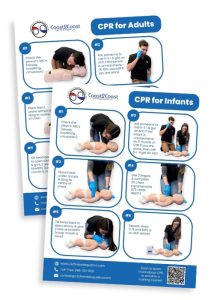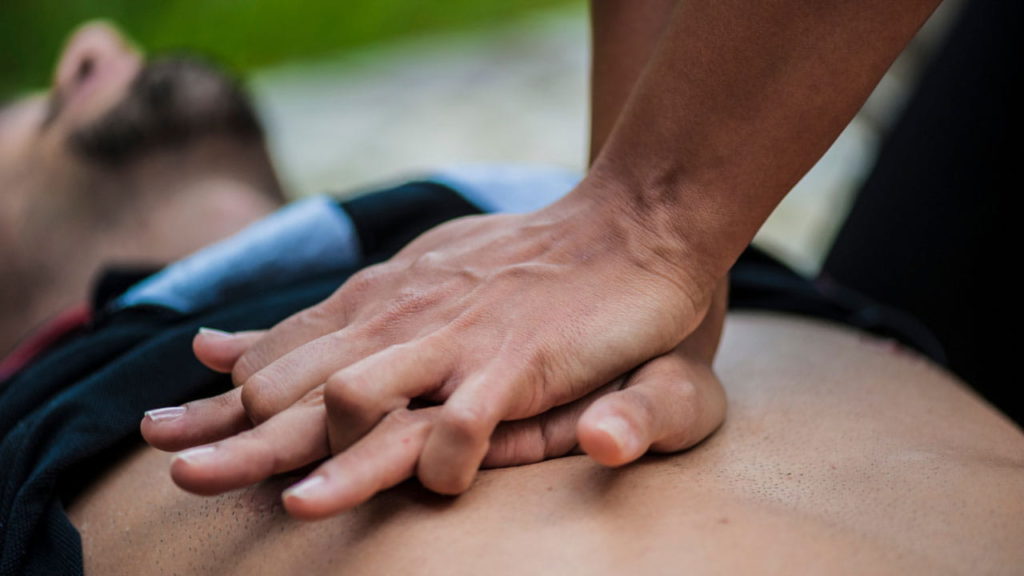A – Airway: Make sure the airway is clear.
B – Breathing: Check for breathing and give rescue breaths if needed.
C – Circulation: Perform chest compressions if no pulse or signs of circulation.
Emergencies happen on a daily basis. If you are ever faced with a medical emergency and a person is unconscious, there are several crucial steps you should take to ensure that person’s survival. One of the most important actions you can take is to perform CPR—a combination of chest compressions and rescue breathing—which can significantly increase the chances of survival until professional help arrives.
When you take one of our First Aid & CPR courses offered in North York, or at any of our other training facilities across Ontario, you will learn all these vital ABC steps. There are many topics included in First Aid training, including the ABCs of cardiopulmonary resuscitation!
When using the ABCs of cardiopulmonary resuscitation, you could be the determining factor between life and death. The ABCs of CPR are part of the “Check, Call, Care” steps that the Canadian Red Cross has implemented into their basic first aid training. “Check, Call, Care” includes the primary assessment a first aider must complete when they encounter a hurt or ill person. When checking the person, they will need to check their ABCs—Airway, Breathing, and Circulation—and be prepared to perform CPR using effective chest compressions and rescue breathing if necessary.
What do the ABCs of CPR stand for?
Save 10% on your
First Aid & CPR Training

A – Airway
You must first check to confirm that the person has an open airway. The airway is the tube that allows air to pass into or out of the lungs, making it impossible to breathe if it is blocked. To open it, you must perform a head-tilt/chin-lift. To do this, you need to tilt the head back and lift the chin until the chin is the highest point (in adults). This action shifts the tongue away from the back of the throat and allows air to reach the lungs—an essential skill taught in any certified first aid course.
This action does not need to be done if the person is speaking, moaning, or crying, meaning that the airway is already open.
It is important to begin your first aid rescue by opening the airway and then proceed to check for breathing for 5–10 seconds. If the person is not breathing normally, you may need to perform rescue breathing. This includes giving two rescue breaths to help oxygenate the lungs before starting chest compressions, a key step in the effort to perform CPR effectively.
Make sure you know exactly how to perform a head-tilt/chin-lift and other life-saving skills by taking our North York CPR/AED course and first aid course.
If the individual has suffered a head and/or spinal injury, open the airway using a jaw thrust instead of a head-tilt/chin-lift. Jaw thrust is a medical technique used to open the airway of a patient in order to facilitate breathing. It is often part of basic first aid and is used when a patient has a blocked airway or is having difficulty breathing, such as during a respiratory arrest or choking.
To perform jaw thrust, the caregiver places their hands on either side of the patient’s head and gently lifts the jaw upwards and forward, using the thumb and fingers to support the mandible (lower jaw). This action helps open the airway by pulling the tongue and other soft tissues away from the back of the throat, allowing air to flow more easily into the lungs—sometimes making it possible to perform rescue breathing or rescue breaths as part of a complete CPR response.
Jaw thrust is typically performed as part of basic life support (BLS) or advanced life support (ALS) protocols, and is usually done in conjunction with other measures to support the patient’s breathing, such as ventilation with a bag-valve mask or placing an advanced airway like an endotracheal tube.

Inquire about CPR Training
B – Breathing
Next in the first aid basics is checking for breathing. As part of your initial assessment, you must determine if the injured person is breathing normally. For a maximum of 5 to 10 seconds, check for signs of normal breathing. With your face turned toward the person’s torso, just above the person’s mouth, listen for breaths and look to see if the chest is rising and falling—an essential skill taught in every certified first aid course.
Here is a list of actions you can take to check for breathing:
Look for visible signs of breathing, such as the chest rising and falling or air moving in and out of the nose or person’s mouth.
Place your ear near the person’s nose and mouth and listen for the sound of breathing.
Place your hand on the person’s chest and feel for movement as they breathe.
If you only see an infrequent gasp of air, the person is not breathing normally. An occasional gasp for air is a reflex action called agonal respiration, which is irregular and ineffective. Agonal breathing is a type of abnormal breathing pattern that can occur in unconscious adults or individuals in cardiac arrest. It is characterized by irregular, shallow breaths, often accompanied by gurgling or grunting sounds.
Agonal breathing is a clear sign of severe oxygen deprivation and is often linked to cardiac arrest—a situation where the heart has stopped beating effectively and vital blood flow is interrupted. In these cases, prompt first aid is crucial. Begin CPR immediately if trained, which includes a combination of chest compressions and rescue breaths to restore vital blood flow and oxygen delivery.
Agonal breathing may also occur in other emergencies like respiratory distress, pneumonia, or a severe airway obstruction. If someone shows signs of agonal breathing, call emergency services immediately and begin basic life support measures. If you’re trained, perform chest compressions followed by rescue breaths, especially in cases involving unconscious adults.

C – Check Circulation
When checking for circulation during a first aid emergency, it is essential to look for deadly bleeding and signs of shock , such as pale, moist, or cool skin. Life-threatening bleeding must be controlled immediately, and you should perform a quick head-to-toe assessment of the injured person. These critical steps are taught in our First Aid & CPR courses available at our first aid facilities. Normal breathing often suggests that the heart is still beating. However, if the person is not breathing normally, their heart may soon stop. In this case, you must perform chest compressions immediately to help maintain blood circulation and preserve brain function until further help arrives.
In cases where a spinal injury is suspected, take extra care to minimize movement during your assessment and while providing first aid.
For advanced training levels such as Basic Life Support (BLS) and Emergency Medical Responder (EMR), checking the pulse is included in the circulation check. For unresponsive adults and children, check the carotid pulse; for unresponsive infants, check the brachial pulse.
If an automated external defibrillator (AED) is available, it should be used as soon as possible in conjunction with chest compressions to increase the person’s chance of survival. AEDs are designed to analyze heart rhythm and deliver a shock if needed, and their use is a key component of effective first aid for cardiac arrest.
If the individual has suffered hypothermia, remember to check the ABCs—Airway, Breathing, and Circulation—for at least 60 seconds to confirm any signs of life before proceeding.

Learn First Aid & CPR
The ABCs of CPR are only a part of what you need to know in case an emergency happens. Many of these first aid techniques must be practiced so that, if there’s any kind of emergency, you’re fully prepared to act quickly and confidently. This is why it’s now mandatory for many professionals across different industries to complete First Aid & CPR training. Professions such as police officers, nurses, and even office workers are often required to maintain valid first aid and CPR certification for their roles.
By enrolling in a first aid and CPR training course with us at Coast2Coast, not only will you learn life-saving skills, but you’ll also gain the confidence needed to provide immediate first aid when someone is in distress. You’ll be taught how to perform chest compressions, deliver rescue breaths, and give two rescue breaths followed by continuous compressions if someone is not breathing.
You’ll also practice assessing the person’s chest for breathing movement, managing airway breathing issues, and understanding how to effectively use items in a first aid kit. These hands-on exercises are essential to ensure you’re ready for real-life emergencies.
You never know when an emergency will strike, which is why we strongly recommend that everyone take a certified first aid and CPR course at some point in their lives. These critical skills could empower you to save a life—whether it’s at home, at work, or in your community.
We’re proud to support the community of North York by helping individuals prepare for emergencies. Register for one of our Canadian Red Cross First Aid and CPR training courses today, and practice the ABCs of CPR using our professional, top-quality training equipment.





















2 Comments
Hi
I am interested to complete CPR A,B and C from Canadian Red cross. Can you please let me know the process and fees. I am living in Toronto. Is there anything in Scarborough area
Thanks
Fazlul
Hi Fazlul,
The best thing for you to do would be to take a CPR/AED level C course. This will cover all of the material that is taught in level A and B as well.
You can register through our website by choosing the location closest to you or you can also call us to register. Prices vary from location to location.
Please feel free to give us a call at 866-291-9121.
Taylor